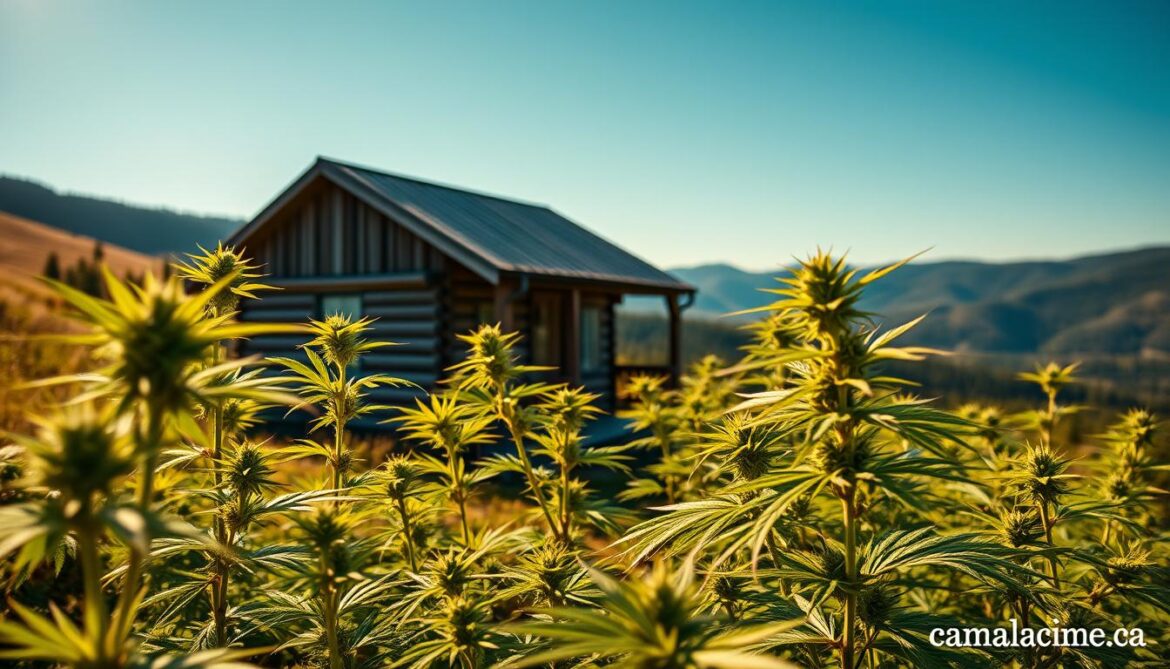Canadians spent over $4 billion on legal marijuana products in 2023. This figure shows huge growth since cannabis legalization in October 2018. The Cannabis Act changed how Canadians access and use these products.
The Act controls production, distribution, and sales of cannabis. It focuses on public health and safety. This guide covers everything you need to know about cannabis in 2024.
You’ll learn about regulations that differ by province. We’ll explore various purchasing options and product types. This resource offers practical advice for responsible use.
We’ve used the latest data from Health Canada. This ensures you have accurate information. Our guide is useful for recreational users, medical patients, and curious individuals.
Let’s explore the complex world of legal herbs together. You’ll gain confidence in navigating this evolving landscape.
The Current State of Cannabis Legalization in Canada
Canada’s cannabis laws have evolved significantly since nationwide legalization six years ago. The 2024 regulatory framework balances public health with consumer access. It governs recreational cannabis through a complex system of rules.
Historical Context of Legalization
On October 17, 2018, Canada became the second country to fully legalize recreational weed. This followed years of advocacy and medical cannabis programs. The Cannabis Act marked a shift in public attitudes toward the plant.
Canada established a medical cannabis system in 2001. This laid the groundwork for future recreational market regulations. Legalization aimed to restrict youth access and displace the illicit market.
Key Updates for 2024
Health Canada has revised Cannabis Health Warning Messages for products. License holders have 12 months to implement these new warnings. This change reflects the government’s focus on public education.
New amendments to the Cannabis Regulations take effect on March 12, 2025. These changes will reduce paperwork for licensed producers. They maintain strict safety standards that define Canada’s cannabis legalization approach.
Provincial Variations in Cannabis Laws
Provinces and territories have their own rules for buying and using cannabis. This creates a diverse regulatory landscape across Canada. It’s crucial to know local laws when traveling.
Ontario and British Columbia mix private retailers with government online stores. Quebec uses a government-controlled model through SQDC. Alberta has the most private shops, while Nunavut only allows online orders.
Public consumption rules vary widely between provinces. Some allow cannabis use wherever tobacco is permitted. Others have stricter policies. Home growing limits range from four plants to total bans.
Understanding Canadian Cannabis Laws and Regulations
Canada’s Cannabis Act governs the use, possession, and sale of cannabis. It aims to protect public health and provide adults with legal access to quality-controlled products. The law sets limits on possession and establishes strict rules for production and distribution.
Federal Cannabis Act Overview
The Cannabis Act took effect on October 17, 2018. It created a legal framework for cannabis control across Canada. The Act focuses on keeping cannabis away from youth and criminals.
It also sets quality standards for cannabis products. This ensures consumers have access to safe, regulated options.
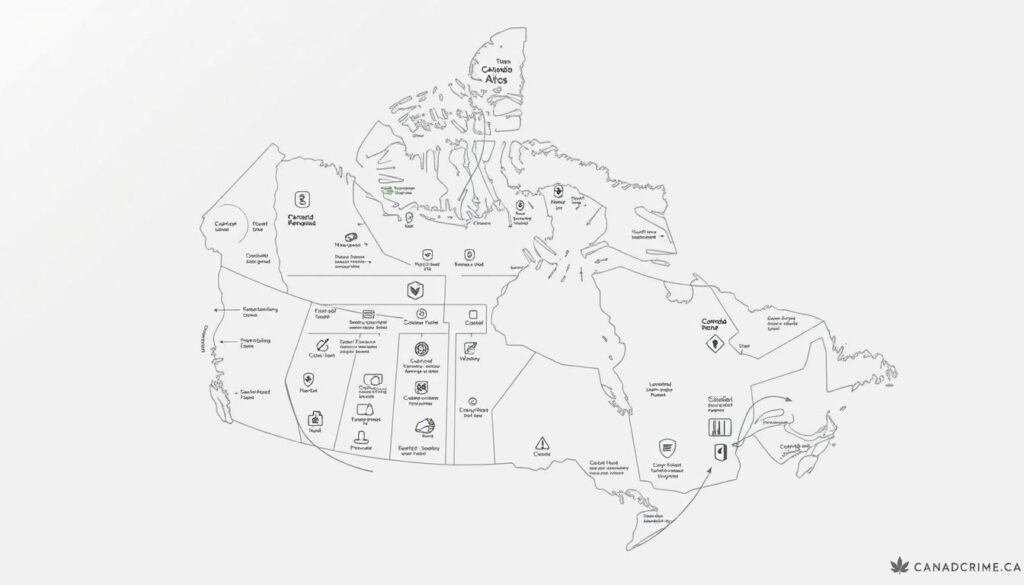
Possession Limits and Age Restrictions
Adults can possess up to 30 grams of dried cannabis in public. Different limits apply to other cannabis products.
The legal age to buy and use cannabis is 18 or 19 in most provinces. Quebec has the highest minimum age at 21.
Criminal Code Provisions for Cannabis Offenses
Some cannabis activities remain illegal. These include possessing more than the legal limit and selling without a license. Providing cannabis to minors is also illegal.
Penalties for Illegal Distribution
Selling cannabis without permission can lead to serious consequences. Penalties range from tickets for small amounts to prison time for larger operations.
Selling to minors is treated very harshly. It can result in up to 14 years in prison.
Impaired Driving Legislation
Canada has strict laws about cannabis and driving. Police can test drivers they suspect of being impaired by THC.
Legal THC limits while driving vary. They range from 2 to 5 nanograms per milliliter of blood.
Penalties for driving high include fines and possible jail time. These rules show Canada’s commitment to road safety alongside cannabis legalization.
Cannabis in Canada: Market Data and Statistics
Canada’s cannabis industry has grown significantly since 2018. It shows unique patterns across provinces. The sector has become a major economic player with distinct regional characteristics.
Industry Growth and Economic Impact
Canada’s cannabis industry has expanded rapidly, boosting the economy. It added $8.26 billion to Canada’s GDP in its first year. The sector has created thousands of jobs nationwide.
Legal cannabis sales now provide substantial tax revenue. These funds support public services and education programs. Provincial and federal taxes generate hundreds of millions annually.
Investment in marijuana has sparked growth in related fields. These include security, agricultural tech, and retail infrastructure. This effect extends the impact beyond direct cannabis sales.
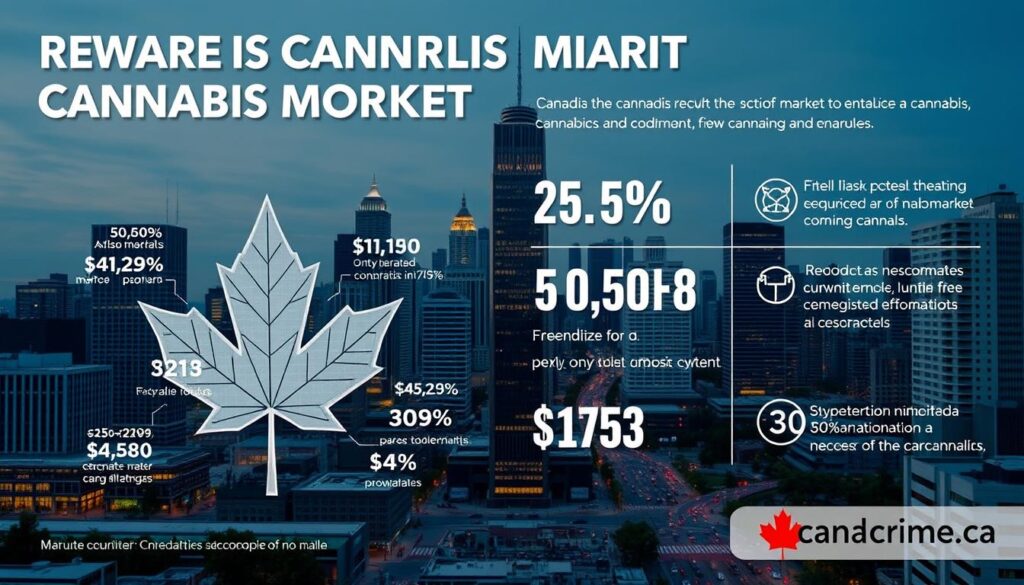
Consumption Trends by Province
26% of Canadians 16 and older used cannabis for non-medical reasons last year. This is up from 22% in 2018 when legalization began.
Nova Scotia and Alberta have the highest usage rates. Quebec shows lower rates despite its large population. Urban areas differ from rural regions in consumption patterns.
Big cities have seen rapid growth in cannabis stores. This reflects higher demand in populated areas. Toronto, Vancouver, and Montreal lead this trend.
Price Comparisons Across Markets
Legal weed prices vary by province due to different tax and retail models. Quebec’s government-run stores offer the lowest prices. Territories have the highest prices because of distribution challenges.
The price gap between legal and illegal cannabis has shrunk since 2018. Legal products now cost about 20% more in many areas. This is down from 80% initially.
Product pricing shows clear patterns. Dried flower is cheapest. Concentrates and some edibles cost more everywhere. These prices reflect production costs and consumer preferences.
Medical Cannabis Access and Patient Rights
Canada’s medical cannabis system ensures safe, legal treatment for qualifying patients. It operates separately from the recreational market. This system offers specific protections and benefits for patients seeking therapeutic cannabis use.
Understanding how to navigate this system is crucial. It helps patients access cannabis for medical purposes effectively.
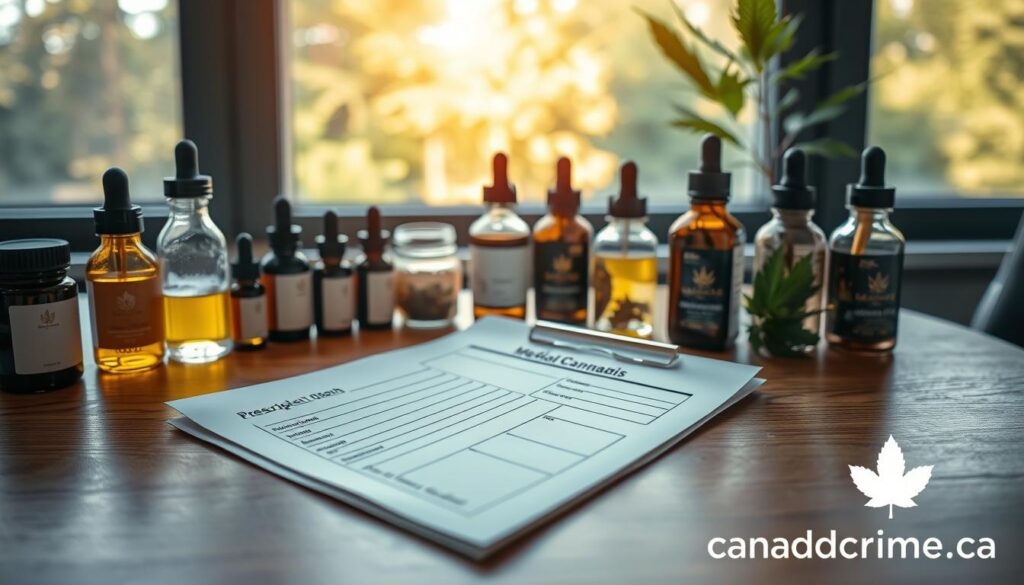
Qualifying for Medical Cannabis
To access medical cannabis in Canada, you need a documented qualifying condition. Canadian healthcare providers can authorize medical cannabis at their discretion.
The process involves several key steps:
- Consulting with a healthcare provider about your condition
- Obtaining a medical document (similar to a prescription)
- Registering with a licensed producer of medical cannabis
- Submitting your medical documentation during registration
Common qualifying conditions include chronic pain, epilepsy, and multiple sclerosis. Anxiety, PTSD, and cancer treatment symptoms may also qualify.
Your healthcare provider will assess your needs. They’ll determine if CBD, THC, or a combination product is appropriate.
Medical vs. Recreational Systems
The medical cannabis system offers advantages over recreational access. Medical users can buy directly from licensed producers.
This often provides access to a wider variety of products. These products have specific CBD:THC ratios for therapeutic use.
Medical cannabis patients have higher possession limits. They can possess up to 150 grams or a 30-day supply.
“Medical cannabis patients require specialized products and consistent access to their medicine. The separate medical system ensures these needs are met while providing important legal protections for patients.”
Insurance Coverage and Tax Deductions
Some private insurance plans now cover medical cannabis. Major insurers offer optional coverage for specific conditions through employer plans.
You can claim medical cannabis expenses on your taxes. Keep all receipts from licensed producers to document these expenses.
Workplace Accommodations
As a medical cannabis patient, you have rights to workplace accommodation. Employers must balance these rights with safety considerations.
From March 12 to April 10, 2025, medical cannabis providers will distribute Consumer Information Documents. These documents contain essential information about safe use and legal considerations.
Recreational Cannabis: Where and How to Buy Legally
Canada offers multiple legal ways to buy recreational cannabis. You can purchase from government-run stores or licensed private retailers. These options ensure you’re buying safe, regulated products that comply with laws.
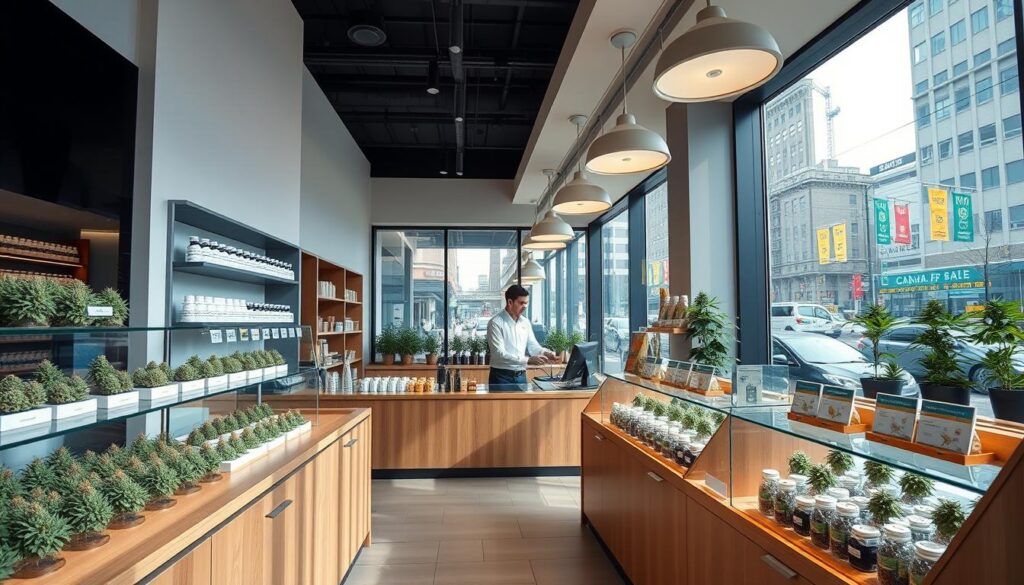
Licensed Retailers Across Provinces
Each province has its own retail model for recreational cannabis. These models fall into three categories:
- Government-operated stores (Quebec, Nova Scotia)
- Private retailers only (Alberta, Saskatchewan)
- Mixed models with both government and private stores (British Columbia, Ontario)
Look for provincial licensing info in stores or on websites. This helps identify legitimate retailers. Ontario stores must display their AGCO authorization certificate. Alberta retailers need visible AGLC licenses.
Store numbers vary by region. Alberta has over 700 licensed stores. Quebec has fewer than 100 SQDC locations for its larger population.
Online Purchasing Options
Legal online cannabis shopping depends on your province. Options include government websites and licensed private retailers with delivery. Some places offer click-and-collect services for in-store pickup.
All legal online platforms require age verification upon delivery. You’ll need government ID proving you meet the minimum age requirement. It’s 19 in most provinces, 18 in Alberta and Quebec.
Understanding Product Labels and Potency
Legal marijuana products have standardized labels. These include THC and CBD content, strain type, and producer information. They also display lot numbers and mandatory health warnings.
Health Canada updated Cannabis Health Warning Messages recently. Producers have 12 months to implement these changes on new weed products.
Packaging and Marketing Restrictions
Canada has strict rules for cannabis packaging and marketing. These include plain packaging and child-resistant containers. No testimonials, endorsements, or youth-appealing elements are allowed.
There are also limits on promotional activities and sponsorships. These measures aim to prevent youth access while informing adult consumers about products.
Cannabis Products and Consumption Methods
Canada’s cannabis market offers a wide range of products and ways to consume them. Most Canadians know cannabis can be habit-forming and risky for teens. However, some knowledge gaps still exist about specific products and their effects.
Let’s explore the options available in Canada’s legal cannabis market. Understanding these choices can help you make informed decisions about cannabis use.
Dried Flower and Pre-rolls
Dried flower is the most popular cannabis product in Canada. It comes in various strains with different THC and CBD ratios. Indica, sativa, and hybrid types offer unique effects, from relaxation to energy.
Pre-rolls are convenient for those who don’t want to handle loose flower. You can smoke dried cannabis using pipes or rolling papers. Vaporizing heats the flower without burning it.
Vaporizing usually produces less smell and may cause fewer breathing issues. However, most Canadians know that vaping cannabis can still be harmful to health.
Edibles, Beverages, and Concentrates
Cannabis-infused foods, drinks, and concentrates offer smoke-free options with longer-lasting effects. These products typically take 30 minutes to 2 hours to work. Peak effects can occur 4+ hours after eating or drinking.
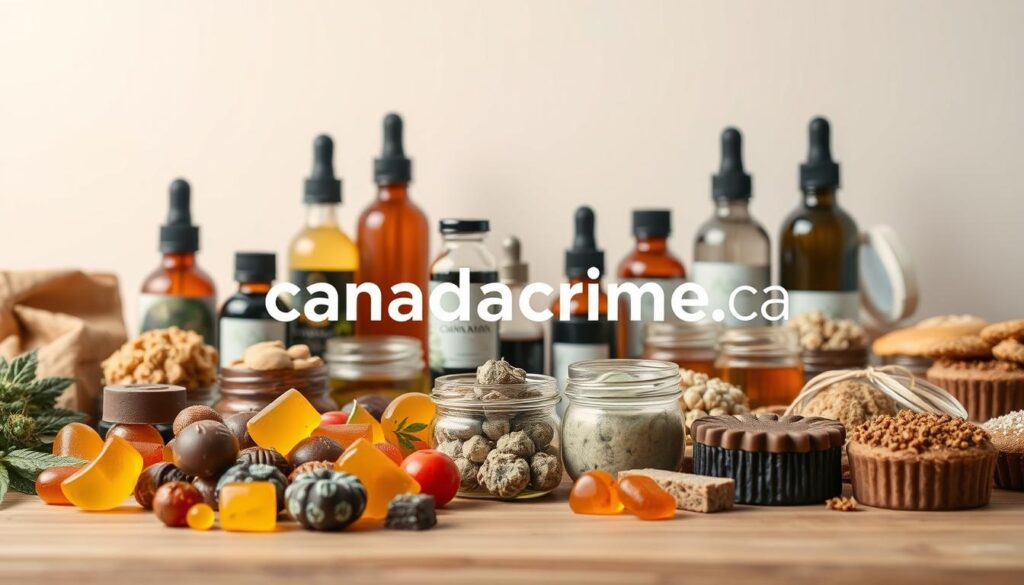
In Canada, edibles and drinks are limited to 10mg THC per package. Concentrates like oils, shatter, and wax can be much stronger. It’s important to start with a low dose and go slow.
CBD Products and Their Legal Status
CBD products are popular for their potential health benefits without getting you high. In Canada, CBD is regulated the same as THC products. This applies whether it comes from hemp or cannabis.
You can find CBD as oils, capsules, topicals, and CBD-dominant flower. These products must follow the same rules as THC-containing items.
Full-Spectrum vs. Isolate CBD
Full-spectrum CBD contains multiple cannabis compounds, including tiny amounts of THC. Many users report better results from this “entourage effect”. The compounds work together to enhance benefits.
CBD isolate products contain only pure cannabidiol. These may be better for those wanting to avoid THC completely. They’re also good for people who react badly to other cannabis compounds.
Dosage Guidelines and Effects
Cannabis affects everyone differently based on body chemistry, consumption method, and product strength. For beginners, start with small doses and wait to see how you feel.
- Dried flower: 1-2 inhalations, waiting 10-15 minutes before more
- Edibles/beverages: 2.5mg THC or less
- CBD: 5-15mg for mild effects, 15-30mg for moderate effects
Signs of taking too much may include anxiety, fast heartbeat, and confusion. If this happens, stay calm and hydrated. Remember, the effects will fade with time.
Always talk to your doctor before using cannabis. This is especially important if you have health conditions or take medications.
Growing Cannabis at Home: Rules and Best Practices
Growing cannabis at home is now legal in Canada. However, rules vary across provinces. It’s important to know these regulations to avoid legal issues.
The Cannabis Act allows Canadians to grow their own plants. But there are specific limits and requirements. These differ depending on where you live.
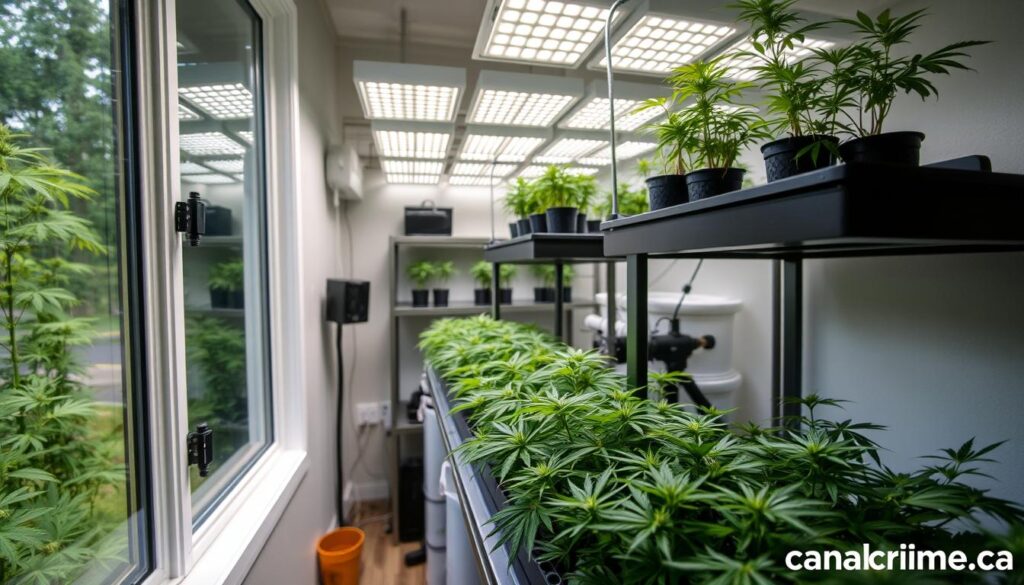
Provincial Home Growing Regulations
Federal law permits adults to grow up to four cannabis plants per household. Yet, provincial rules create a diverse landscape. Quebec and Manitoba have banned home cultivation entirely.
British Columbia, Alberta, and Ontario follow the federal four-plant limit. Other provinces have added restrictions. New Brunswick requires locked indoor growing areas. Nova Scotia mandates that plants must be inaccessible to minors.
The ability to grow cannabis at home empowers Canadians to produce their own medicine and recreational products, but with that freedom comes the responsibility to understand and follow local regulations.
Basic Cultivation Requirements
Cannabis plants need specific care to thrive. They require 18-24 hours of light during growth. This changes to 12 hours when flowering begins.
You can grow in soil, coco coir, or hydroponic systems. Each method needs different nutrients. Plants do best in temperatures between 20-25°C. Humidity should be 40-70%, depending on growth stage.
Canada’s climate limits outdoor growing to May through October. Indoor growing is possible year-round. However, it needs more equipment and costs more energy.
Legal Considerations for Home Growers
There are more rules beyond plant count limits. Plants must not be visible from public spaces. This may require privacy screens or indoor growing.
Renters should check their lease agreements. Landlords can ban cannabis cultivation on their properties. Condo boards may also have rules against home growing.
Starting materials must come from legal sources. These include licensed retailers or other legal growers. Federal license holders can provide starting material too.
Selling home-grown cannabis is strictly prohibited under Canadian law. Your harvest is for personal use only. This applies no matter how successful your growing efforts are.
Cannabis Tourism and Travel Within Canada
Cannabis tourism is booming in Canada’s travel industry. It offers unique experiences while travelers navigate different provincial rules. Many Canadians now include cannabis in their travels, showing its growing acceptance.
Recent surveys show cannabis is the second most socially acceptable substance in Canada. It follows alcohol but ranks above e-cigarettes and tobacco.
Interprovincial Travel with Cannabis
You can legally carry up to 30 grams of dried cannabis when traveling between provinces. This federal limit applies across all provinces, making interprovincial travel legally straightforward.
Cannabis is allowed in carry-on and checked baggage for air travel within Canada. Store products in odor-proof containers with original packaging and excise stamps intact.

Cannabis-Friendly Accommodations
New cannabis-friendly lodging options are popping up across Canada. These range from boutique hotels with special consumption areas to vacation rentals allowing cannabis use.
When booking, look for these cannabis-friendly signs:
- Designated smoking areas or balconies
- “420-friendly” mentions in property descriptions
- Explicit cannabis policies on booking sites
- Cannabis amenities or welcome packages
Public Consumption Rules by Province
Public consumption rules vary greatly across Canada. British Columbia and Alberta have relaxed rules. Quebec and Manitoba maintain stricter limits.
Most provinces apply similar restrictions to cannabis as tobacco smoking. This means no consumption in:
- Indoor public spaces
- Areas frequented by children
- Vehicles (even as a passenger)
- Within specified distances from building entrances
Border Crossing Considerations
Never try to cross international borders with cannabis. It’s illegal even when going to U.S. states where cannabis is legal. The consequences can be severe.
“Transporting cannabis across the Canadian border in any direction is a serious criminal offense with penalties of up to 14 years in prison.”
Admitting previous cannabis use to U.S. border officials can result in entry denial. For international travel, leave your products at home. Research local laws at your destination.
Conclusion: Navigating Canada’s Cannabis Landscape in 2024
Canada’s cannabis regulations are evolving based on research and public feedback. Staying informed about these changes is crucial. The legal framework has become more refined in 2024.
Health Canada now publishes semi-annual cannabis inspection data on the Open Government Portal. This adds to their annual Compliance & Enforcement Report. You can now access vital information about the legal market’s integrity.
The cannabis industry is shifting significantly this year. Product innovation has expanded beyond dried flower to include hemp products and new consumption methods. Market consolidation is reshaping retail options while prices stabilize across provinces.
Medical patients now enjoy improved access with streamlined registration processes. Recreational users benefit from clearer product labeling and potency information. This makes informed choices easier for everyone.
The Canadian system offers a structured approach to cannabis legalization. Home cultivation, provincial variations, and legalization progress are all part of this framework. As public acceptance grows, cannabis is becoming part of mainstream Canadian culture.
Understanding personal limits and risks is key to navigating Canada’s cannabis framework responsibly. Ongoing regulation refinement shows Canada’s commitment to balancing access with public health. This model continues to influence global cannabis policy.

